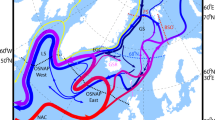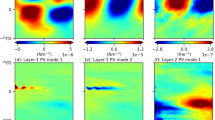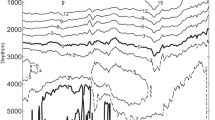Abstract
Experiments with the coupled climate model CLIMBER-3α, which contains an oceanic general circulation model, show deep upwelling in the Southern Ocean to be proportional to the surface wind stress in the latitudinal band of Drake Passage. At the same time, the distribution of the Southern Ocean upwelling onto the oceanic basins is controlled by buoyancy distribution; the inflow into each basin being proportional to the respective meridional density difference. We observe approximately the same constant of proportionality for all basins, and demonstrate that it can be directly related to the flow geometry. For increased wind stress in the Southern Ocean, the overturning increases both in the Atlantic and the Indo-Pacific basin. For strongly reduced wind stress, the circulation enters a regime where Atlantic overturning is maintained through Pacific upwelling, in order to satisfy the transports set by the density differences. Previous results on surface buoyancy and wind stress forcing, obtained with different models, are reproduced within one model in order to distill a consistent picture. We propose that both Southern Ocean upwelling and meridional density differences set up a system of conditions that determine the global meridional overturning circulation.









Similar content being viewed by others
Notes
We use the term ‘driving mechanism’ in the sense of the mechanism providing the input of potential energy required to sustain a deep overturning circulation.
Here, we neglect spatial variation of ν hor . In the model, the latitudinal variation of ν hor is small in low and middle latitudes.
An example for a 2-dimensional quadratic profile would be v(x,z) = 16 v max x(x−L x )(z−D)(z−D−δ)/L 2 x δ2. An example for a sine profile would be v(x,z) = v max sin(πx/L x ) sin(π (z−D)/δ).
References
Döös K, Webb DJ (1994) The Deacon Cell and the other meridional cells of the Southern Ocean. J Phys Oceanogr 24 (2):429–442
Fichefet T, Maqueda MAM (1997) Sensitivity of a global sea ice model to the treatment of ice thermodynamics and dynamics. J Geophys Res 102:12609–12646
Ganachaud A, Wunsch C (2000) Improved estimates of global ocean circulation, heat transport and mixing from hydrographic data. Nature 408:453–457
Ganachaud A, Wunsch C (2003). Large-scale ocean heat and freshwater transports during the World Ocean Circulation Experiment. J Climate 16:696–705
Gent PR, McWilliams JC (1990) Isopycnal mixing in ocean circulation models. J Phys Oceanogr 20:150–155
Gnanadesikan A (1999) A simple predictive model for the structure of the oceanic pycnocline. Science 283:2077–2079
Gnanadesikan A, de Boer AM, Mignone BK (2007) A simple theory of the pycnocline and overturning-revisited. In: Schmittner A, Chiang J, Hemming S (eds) Past and future changes of the ocean’s meridional overturning circulation. Geophysical monograph series, vol 173, pp 19–32
Griesel A, Morales-Maqueda MA (2006) The relation of meridional pressure gradients to North Atlantic Deep Water volume transport in an OGCM. Climate Dyn 26:781–799
Hallberg R, Gnanadesikan A (2006) The role of eddies in determining the structure and response of the wind-driven Southern Hemisphere overturning: results from the Modeling Eddies in the Southern Ocean (MESO) project. J Phys Oceanogr 36:2232–2252
Hasumi H, Suginohara N (1999) Effects of locally enhanced vertical diffusivity over rough bathymetry on the world ocean circulation. J Geophys Res 104:23364–23374
Hofmann M, Maqueda MAM (2006) Performance of a second-order moments advection scheme in an Ocean General Circulation Model. J Geophys Res 111:C05006
Hogg NG (1983) A note on the deep circulation of the western North Atlantic: its nature and its causes. Deep-Sea Res 30:945–961
Huang R (1999) Mixing and energetics of the oceanic thermohaline circulation. J Phys Oceanogr 29:727–746
Hughes TMC, Weaver AJ (1994) Multiple equilibria of an asymmetric 2-basin ocean model. J Phys Oceanogr 24:619–637
Johnson HL, Marshall DP (2002) A theory for the surface atlantic response to thermohaline variability. J Phys Oceanogr 32:1121–1132
Johnson HL, Marshall DP, Sproson DAJ (2007) Reconciling theories of a mechanically driven meridional overturning circulation with thermohaline forcing and multiple equilibria. Climate Dyn 29:821–836
Kistler R et al (2001) The NCEP/NCAR 50-year reanalysis. Bull Am Meteor Soc 82:247–267
Kuhlbrodt T, Griesel A, Montoya M, Levermann A, Hofmann M, Rahmstorf S (2007) On the driving processes of the Atlantic meridional overturning circulation. Rev Geophys 45:RG2001
Large WG, McWilliams JC, Doney SC (1994) Oceanic vertical mixing: a review and a model with a nonlocal boundary layer parameterization. ROG 32:363–404
Ledwell JR, Montgomery ET, Polzin KL, Schmitt LC, Toole JM (2000) Evidence for enhanced mixing over rough topography in the abyssal ocean. Nature 403:179–182
Lee TN, Johns WE, Zantopp RJ, Fillenbaum ER (1996) Moored observations of Western Boundary current variability and thermohaline circulation at 26.5°N in the subtropical North Atlantic. J Phys Oceanogr 26:962–983
Levermann A, Griesel A (2004) Solution of a model for the oceanic pycnocline depth: Scaling of overturning strength and meridional pressure difference. Geophys Res Lett 31:L17302
Levermann A, Schewe J, Montoya M (2007) Lack of bipolar see-saw in response to Southern Ocean wind reduction. Geophys Res Lett 34(12):L12711
Manabe S, Stouffer RJ (1995) Simulation of abrupt climate change induced by freshwater input to the North Atlantic Ocean. Nature 378:165–167
Marotzke J (1997) Boundary mixing and the dynamics of three-dimensional thermohaline circulations. J Phys Oceanogr 27:1713–1728
Marotzke J, Welander P, Willebrand J (1988) Instability and multiple steady states in a meridional-plane model of the thermohaline circulation. Tellus A 40:162–172
Marzeion B, Drange H (2006) Diapycnal mixing in a conceptual model of the Atlantic meridional overturning circulation. Deep-Sea Res II 53(1-2):226–238
Mignot J, Levermann A, Griesel A (2006) A decomposition of the Atlantic meridional overturning circulation into physical components using its sensitivity to vertical diffusivity. J Phys Oceanogr 36:636–650
Montoya M, Griesel A, Levermann A, Mignot J, Hofmann M Ganopolski A, Rahmstorf S (2005) The Earth System Model of Intermediate Complexity CLIMBER-3α. Part I: description and performance for present day conditions. Climate Dyn 25:237–263
Munk W (1950) On the wind-driven ocean circulation. J Meteorol 7:80–93
Munk W (1966) Abyssal recipes. Deep-Sea Res 13:707–730
Munk W, Wunsch C (1998) Abyssal recipes II. Deep-Sea Res I 45:1977–2010
Naveira Garabato AC, Stevens DP, Watson AJ, Roether W (2007) Short-circuiting of the overturning circulation in the Antarctic Circumpolar Current. Nature 447:194–197
Nof D (2003) The Southern Ocean’s grip on the northward meridional flow. Prog Oceanogr 56:223–247
Petoukhov V, Ganopolski A, Brovkin V, Claussen M, Eliseev A, Kubatzki C, Rahmstorf S (2000) CLIMBER-2: a climate system model of intermediate complexity. Part I: model description and performance for present climate. Climate Dyn 16:1–17
Pickart RS, Smethie WM Jr (1993) How does the deep western boundary current cross the Gulf Stream? J Phys Oceanogr 23:2602–2616
Prather MJ (1986) Numerical advection by conservation of second-order moments. J Geophys Res 91:6671–6681
Rahmstorf S (1996) On the freshwater forcing and transport of the Atlantic thermohaline circulation. Climate Dyn 12:799–811
Rahmstorf S et al (2005) Thermohaline circulation hysteresis: a model intercomparison. Geophys Res Lett 32:L23,605
Richardson PL (1977) On the crossover between the Gulf Stream and the western boundary undercurrent. Deep-Sea Res 24:139–159
Speer K, Rintoul SR, Sloyan B (2000) The diabatic Deacon Cell. J Phys Oceanogr 30:3212–3222
Stommel H (1961) Thermohaline convection with two stable regimes of flow. Tellus 13:224–230
Talley LD, Reid JL, Robbins PE (2003) Data-based meridional overturning streamfunctions for the global ocean. J Climate 16:3213–3226
Toggweiler JR, Samuels B (1993) Is the magnitude of the deep outflow from the Atlantic ocean actually governed by southern hemisphere winds? In: Heimann M (ed) The global carbon cycle. NATO ASI Ser. I, Springer-Verlag
Toggweiler JR, Samuels B (1995) Effect of Drake Passage on the global thermohaline circulation. Deep-Sea Res 42:477–500
Toggweiler JR, Samuels B (1998) On the ocean’s large-scale circulation near the limit of no vertical mixing. J Phys Oceanogr 28:1832–1852
Trenberth K, Olson J, Large W (1989) A global ocean wind stress climatology based on ECMWF analyses. Tech Rep NCAR/TN-338+STR. National Center for Atmospheric Research, Boulder
Whitworth T, Warren BA, Nowlin WD Jr, Rutz SB, Pillsbury RD, and Moore MI (1999) On the deep western-boundary current in the Southwest Pacific Basin. Prog Oceanogr 43:1–54
Wright DG, Stocker TF (1991) A zonally averaged ocean model for the thermohaline circulation. Part I: model development and flow dynamics. J Phys Oceanogr 21:1713–1724
Wright DG, Stocker TF (1992) Sensitivities of a zonally averaged global ocean circulation model. J Geophys Res 97:12707–12730
Wright DG, Stocker TF, Mercer D (1998) Closures used in zonally averaged ocean models. J Phys Oceanogr 28:791–804
Wunsch C, Ferrari R (2004) Vertical mixing, energy and the general circulation of the oceans. Annu Rev Fluid Mech 36:281–314
Yang J (2003) On the importance of resolving the western boundary layer in wind-driven ocean general circulation models. Ocean Model 5:357–379
Zickfeld K, Slawig T, Rahmstorf S (2004) A low-order model for the response of the Atlantic thermohaline circulation to climate change. Ocean Dyn 54:8–26
Acknowledgment
We thank A. Naveira Garabato for a helpful discussion on eddy momentum fluxes. J. S. was funded by the Heinrich Böll Foundation.
Author information
Authors and Affiliations
Corresponding author
Rights and permissions
About this article
Cite this article
Schewe, J., Levermann, A. The role of meridional density differences for a wind-driven overturning circulation. Clim Dyn 34, 547–556 (2010). https://doi.org/10.1007/s00382-009-0572-1
Received:
Accepted:
Published:
Issue Date:
DOI: https://doi.org/10.1007/s00382-009-0572-1




